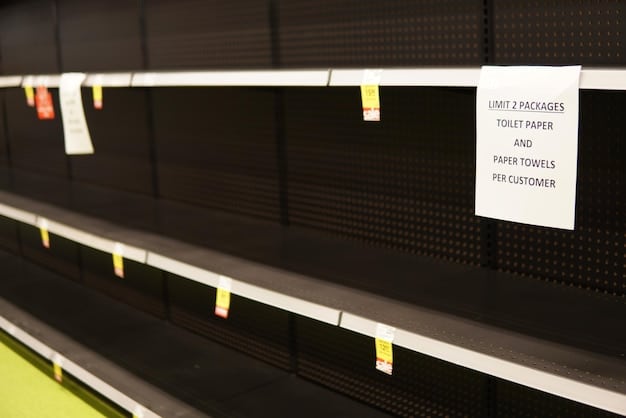Supply Chain Disruptions: How They’re Hitting Your Wallet

Supply chain disruptions continue to impact the US economy, contributing to inflation and limiting the availability of consumer goods, affecting everything from groceries to electronics and automobiles.
Are you noticing higher prices and empty shelves? Supply chain disruptions are a key factor, causing ripple effects throughout the US economy and directly impacting consumers like you.
Understanding Supply Chain Disruptions
Supply chain disruptions are a complex issue with far-reaching consequences. They affect businesses, consumers, and the overall economy, impacting the availability and affordability of goods and services.
These disruptions can stem from a variety of factors, including geopolitical events, natural disasters, and even shifts in consumer demand. Let’s delve deeper into the causes and impacts of these ongoing issues.
What Causes Supply Chain Disruptions?
Several factors contribute to the ongoing supply chain disruptions.
Understanding these root causes is crucial for developing effective strategies to mitigate their impact.
- Geopolitical Instability: Conflicts, trade wars, and political tensions can disrupt established trade routes and limit access to essential resources.
- Natural Disasters: Hurricanes, earthquakes, and other natural disasters can damage infrastructure, disrupt production, and delay shipments.
- Pandemics and Health Crises: The COVID-19 pandemic exposed vulnerabilities in global supply chains, leading to factory closures, labor shortages, and transportation bottlenecks.
- Increased Consumer Demand: A surge in demand for certain goods can overwhelm existing supply chains, leading to shortages and delays.

In conclusion, supply chain disruptions are a result of complex issues stemming from multiple sources. Addressing these issues requires understanding how they can impact different factors in logistics.
The Impact on Inflation
One of the most significant consequences of supply chain disruptions is their contribution to inflation. As goods become scarcer and more difficult to obtain, businesses are forced to raise prices, passing the increased costs on to consumers.
This inflationary pressure can erode purchasing power and make it more difficult for households to afford essential goods and services.
How Supply Chain Issues Fuel Inflation
The connection between supply chain disruptions and inflation is a direct one.
Limited supply coupled with consistent or increased demand drives prices upwards.
- Increased Production Costs: Disruptions can lead to higher costs for raw materials, manufacturing, and transportation.
- Limited Availability of Goods: When supply cannot meet demand, prices naturally increase due to scarcity.
- Higher Transportation Costs: Delays and bottlenecks in shipping and logistics can drive up transportation costs, which are then passed on to consumers.
In summary, the effects of supply chain disruptions are a major catalyst for inflating prices of everyday goods. Stabilizing logistics is a key step in controlling inflation.
Consumer Goods Availability: Shortages and Delays
Beyond inflation, supply chain disruptions also impact the availability of consumer goods. Shortages and delays have become increasingly common, leaving consumers frustrated and unable to find the products they need.
This can affect everything from everyday household items to major purchases like electronics and automobiles.
Examples of Goods Affected by Shortages
Numerous sectors have experienced shortages and delays due to supply chain disruptions.
These examples shows just how pervasive the issue has become.
- Electronics: Semiconductors shortages have impacted the production of smartphones, laptops, and gaming consoles.
- Automobiles: Car manufacturers have been forced to reduce production due to a lack of microchips, leading to longer wait times for new vehicles.
- Groceries: Certain food items, such as canned goods and imported produce, have experienced sporadic shortages due to transportation delays and labor shortages.

The consumer market has been affected immensely. By understanding the scope of the problem, we can anticipate shortages and adjust accordingly.
Strategies for Mitigating Supply Chain Disruptions
While supply chain disruptions may seem unavoidable, businesses and policymakers can take steps to mitigate their impact. Diversifying suppliers, investing in technology, and improving communication can help to build more resilient supply chains.
These strategies can help to reduce the risk of future disruptions and minimize their consequences.
Building More Resilient Supply Chains
Several strategies can help businesses build more resilient supply chains.
Being flexible and adaptable is crucial in today’s volatile environment.
- Diversifying Suppliers: Relying on a single supplier can be risky. Spreading sourcing across multiple suppliers reduces dependence on any one source.
- Investing in Technology: Implementing advanced technologies such as AI and blockchain can improve visibility and efficiency across the supply chain.
- Improving Communication: Clear and consistent communication between all stakeholders can help to identify and address potential disruptions early on.
Adjustments to the supply chain process such as these can significantly reduce the consequences of disruptions.
Government Policies and Interventions
Governments also have a role to play in addressing supply chain disruptions. Policies that promote infrastructure investment, trade facilitation, and workforce development can help to strengthen supply chains and reduce vulnerabilities.
These interventions can create a more stable and predictable environment for businesses to operate in.
How Government Policies Can Help
Government policies can play a crucial role in mitigating supply chain disruptions.
Strategic interventions can strengthen and stabilize supply chains.
- Investing in Infrastructure: Upgrading ports, roads, and railways can improve the flow of goods and reduce transportation bottlenecks.
- Trade Facilitation: Streamlining customs procedures and reducing trade barriers can facilitate the movement of goods across borders.
- Workforce Development: Investing in training and education programs can help to address labor shortages and ensure a skilled workforce for the logistics industry.
The government can and should plan an active role in stabilizing our economy.
Looking Ahead: The Future of Supply Chains
Supply chain disruptions are likely to remain a challenge for the foreseeable future. However, by adopting innovative strategies and embracing new technologies, businesses and governments can build more resilient and adaptable supply chains.
This will be essential for mitigating the impact of future disruptions and ensuring a stable and prosperous economy.
Embracing Innovation and Technology
The future of supply chains will be shaped by innovation and technology.
Embracing these advancements is essential for building resilient and efficient supply chains.
- Artificial Intelligence (AI): AI can be used to optimize logistics, predict demand, and identify potential disruptions.
- Blockchain Technology: Blockchain can enhance transparency and traceability across the supply chain, reducing the risk of fraud and delays.
- Automation: Automating tasks such as warehousing and transportation can improve efficiency and reduce labor costs.
In the future, it is possible that the integration of these resources will be critical for the survival of businesses.
| Key Point | Brief Description |
|---|---|
| 🌍 Geopolitical Instability | Conflicts disrupt trade routes and limit resources. |
| 📈 Impact on Inflation | Increased production costs and limited availability drive up prices. |
| 💡 Mitigation Strategies | Diversifying suppliers and investing in tech builds resilience. |
| 🏛️ Government Policies | Infrastructure and trade facilitation bolster supply chains. |
FAQ Section
▼
Supply chain disruptions are events that interrupt the normal flow of goods and services from suppliers to consumers. These disruptions can be caused by a variety of factors, including natural disasters, geopolitical events, and economic downturns.
▼
Supply chain disruptions can lead to higher prices for goods and services due to increased production and transportation costs. When supply is limited and demand remains constant or increases, businesses often pass these costs on to consumers, driving up inflation.
▼
Many consumer goods have been affected by supply chain disruptions, including electronics (such as smartphones and gaming consoles), automobiles (due to semiconductor shortages), and certain food items (like imported produce and canned goods). This is because all supplies and demand have been affected.
▼
Businesses can diversify their suppliers, invest in technology to improve supply chain visibility, and enhance communication with all stakeholders. Building more resilient supply chains can help to minimize the impact of future disruptions and ensure business continuity.
▼
Government policies can support infrastructure investment, streamline trade processes, and promote workforce development. These measures can help to strengthen supply chains and reduce vulnerabilities, fostering a more stable and predictable economic environment for businesses and consumers.
Conclusion
In conclusion, supply chain disruptions continue to pose significant challenges to the US economy, impacting inflation and the availability of consumer goods. While these disruptions are complex and multifaceted, businesses, governments, and consumers can take proactive steps to mitigate their effects and build more resilient supply chains for the future.